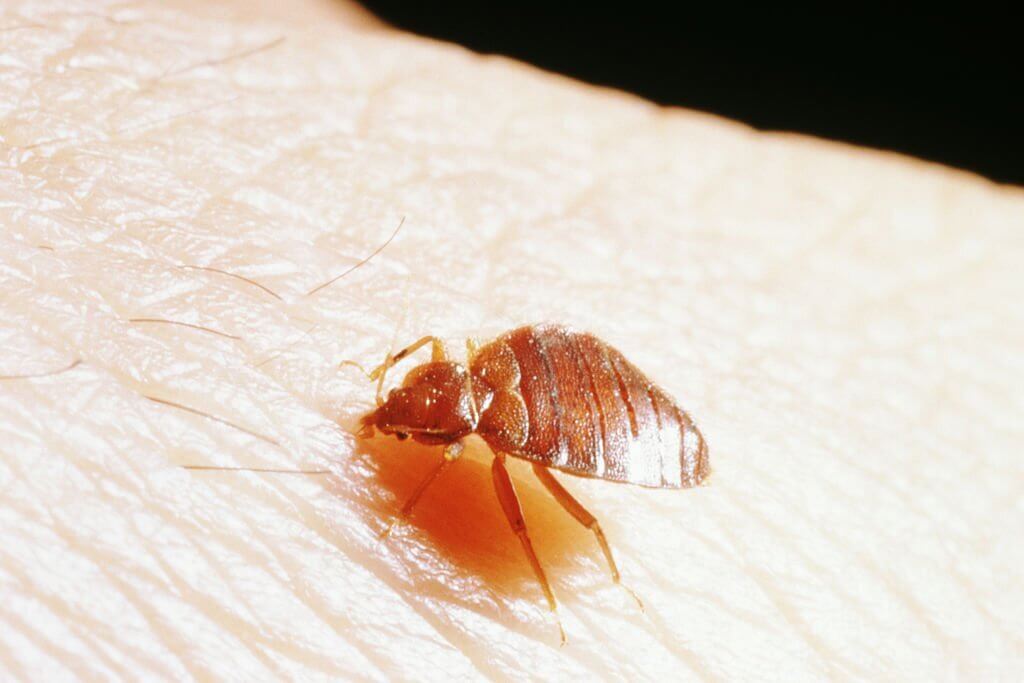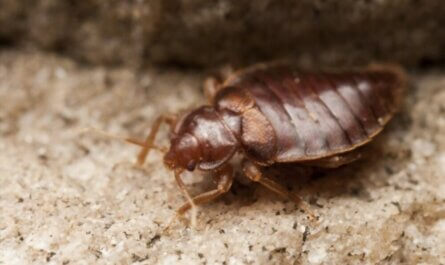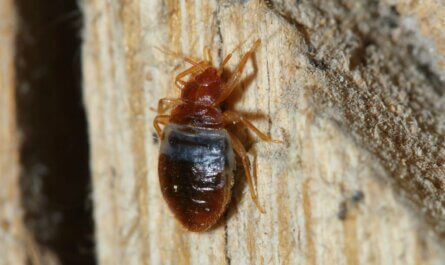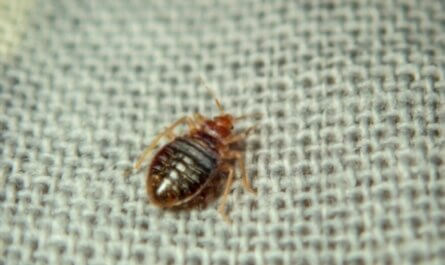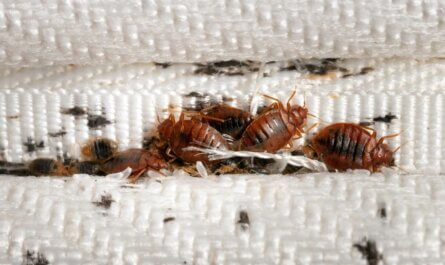Are you dealing with pesky and tiny bed bugs at home? Baby bed bugs, also known as larvae or nymphs, are the immature stages of adult bed bugs. An adult baby bed bug can be as small as an apple seed when fully grown but they’re much smaller while in their infancy stage.
This blog post will help you to understand how to identify baby bed bugs, their behavior and impact, and effective methods for getting rid of them. Take a deep breath; we will walk you through this journey one step at a time so that you can take control now!
Key Takeaways
- Baby bed bugs are tiny insects which range in color from white to brown and measure approximately 1.5mm in size.
- Baby bed bug bites can cause skin irritation, redness, itching or difficulty sleeping.
- Bed bug nymphs and adults require a regular blood meal for growth and reproduction, with adult female bedbugs laying one to five eggs per day up to 250 during their lifetime.
- Effective methods for eliminating baby bed bugs include vacuuming, using dryers on high heat, steam mops and insecticides or natural sprays
Appearance and Life Cycle of Baby Bed Bugs
Baby bed bugs are about the size of an apple seed and can range in color from white to brown.
What do baby bed bugs look like?
Baby bed bugs, or nymphs, are much smaller than adults and can be almost translucent when unfed. They have flat bodies with two thin antennae and six legs that resemble miniature versions of adult bed bugs.
When freshly fed baby bed bugs may appear a white-yellow hue but can become more brown gradually as they mature. Because they are so small, baby bed bugs often times go unnoticed by the untrained eye due to their size difference when compared to an adult bug—adult sizes range from 3mm-6mm long while baby ones measure at 1.5mm in length or slightly larger dependent on maturity level.
Additionally, Distinguishing between young stages of a bed bug’s life cycle may not always be easy even for pest control professionals as adult and babies share many physical features making it important to carefully inspect any suspected area where symptoms have been seen.
Size and color of baby bed bugs
Baby bed bugs are only 1/16 inch in size and change color as they go through their life span. When newly hatched, baby bedbugs have a distinct whitish, straw-colored or translucent look.
As baby bed bugs age, the color transitions to an orange-brown or dark brown until it turns almost black after they take their first blood meal. At this point, the abdomen will appear reddish in color due to them ingesting a blood meal.
The initial stages of growth for adult bed bugs is similar; however their body shape starts out more slender compared to younger nymphs which tend towards being rounder bodied and shorter than adults.
Bed bug nymphs Vs. Adult bed bugs
Understanding the difference between bed bug nymphs and adult bed bugs can be instrumental in identifying a bed bug infestation. Here’s a comprehensive comparison of these two stages of bed bugs:
| Bed Bug Nymphs | Adult Bed Bugs | |
|---|---|---|
| Size | Smaller than adults, but can be seen clearly with the naked eye | About the size of an apple seed. |
| Color | Whitish-yellow, turning reddish-brown after feeding. | Brown in color, turning darker or more reddish after a blood meal. |
| Appearance | Similar to adult bed bugs but smaller and lighter in color. | Flat, oval-shaped bodies with small, stubby antennae and wing pads. |
| Behavior | Crawl rapidly over floors, but do not fly or jump. | Also crawl quickly but do not fly or jump. Engage in mating after a blood meal. |
| Feeding Habits | Feed on blood but do not require a blood meal for each stage of growth. | Require regular blood meals to reproduce, feeding usually occurs at night. |
Recognizing these key differences in bed bug nymphs and adult bed bugs can contribute to their prompt identification, enabling a faster and more effective response to manage infestations.
Do baby bed bugs lay eggs?
Behavior and Impact of Baby Bed Bugs
Discover how baby bed bugs can impact people and our surroundings and what you can do to get rid of them.
Do baby bed bugs bite?
Yes, baby bed bugs bite humans in order to feed on their blood. Baby bed bug bites are typically small and can cause skin irritation and other allergic reactions such as itching or redness.
They may also induce trouble sleeping due to the skin discomfort caused by their bites. Although they are difficult to detect since they hide well, people often suspect that baby bed bugs have bitten them when they find an actual bug or notice a cluster of itchy marks on their skin.
Unlike fleas and mosquitoes, baby bed bugs do not only bite certain areas of the body but can suck the blood from anywhere on human hosts. As such, one should be aware that regular inspection for signs of these insects is necessary in order to keep away any potential infestations which can grow into big problems if left unaddressed.
Baby bed bug bites vs. adult bed bug bites
When dealing with bed bug infestations, it’s crucial to understand that both baby (nymphs) and adult bed bugs can bite and cause discomfort. Despite their size differences, the impact of their bites can be similar. Here’s a straightforward comparison:
| Baby Bed Bug Bites | Adult Bed Bug Bites | |
|---|---|---|
| Appearance | Look similar to adult bed bug bites. Cause red and swollen marks. | Can cause red and swollen marks that are itchy and irritating. |
| Size | The size of the bite does not depend on the size of the bed bug, but rather on who they are biting. | Size of the bite does not depend on the size of the bed bug, but rather on who they are biting. |
| Effect | Can cause skin irritation and difficulty sleeping. Scratching leads to skin lesions. | Can cause severe allergic reactions in rare cases. Frequent biting can cause skin irritation and difficulty sleeping. |
| Result of Scratching | Scratching baby bed bug bites can lead to skin lesions. | Scratching adult bed bug bites can lead to skin lesions. |
To prevent and control infestations, it’s essential to identify the signs of both baby and adult bed bugs to ensure that any extermination efforts will be successful.
Where do baby bed bugs hide?
Baby bed bugs are astute and adaptable pests that can travel and hide in a variety of places. In addition to the many hidden nesting spots within your home – such as mattresses, box springs, bed frames, headboards, furniture, carpets, upholstery, clothing items or even baseboards or wall voids – baby bed bugs may also be transported when people carry items from one place to another.
Even second-hand furniture purchases could lead to an infestation of baby bedbugs if precautionary steps aren’t taken prior to making the purchase.
Guests staying in hotels are especially vulnerable to transport these young insects since they rarely inspect their beds for signs of trouble before settling down for the night.
Air travelers should always check their luggage thoroughly before heading out on vacation; adult female bedbugs lay eggs wherever there is a food source nearby which means any waiting baggage holds might harbor a substantial problem.
How to Identify and Get Rid of Baby Bed Bugs
To accurately get rid of baby bed bugs, it is important to first identify them correctly by checking specific signs as well as implementing various and effective methods for elimination.
How to check for baby bed bugs
To accurately identify baby bed bugs, one must first familiarize themselves with the characteristics and behavior of adult bed bugs. As a general rule, it is recommended to thoroughly check areas where bed bugs are likely to hide such as beds, carpets, window and door frames, furniture seams, baseboards etc. Here are some methods for checking for baby bed bugs:
- Visual inspection: It is important to have a flashlight handy and use it in dark spaces like crevices and underneath carpets. Bed bug nymphs are easier to miss due to their size but being aware of their color (light yellow-white) can help in detection.
- Use Pets: Dogs specially trained in detecting bed bugs can be useful particularly when searching for large infestations that cannot be detected through visual inspections alone.
- Use traps or Interceptor cups: The interceptor cup is placed beneath furniture legs or bed posts. These work by trapping and containing any live bedbugs that climb up or down the furniture legs so they can be identified more easily.
- Thermal Imaging: Thermal imaging cameras can pickup thermal anomalies near beds & mattresses that could be caused by warm-blooded prey – i.e., humans or their pets), making them perfect for finding even the smallest rash of baby bed bugs in tight spots around the house .
Effective methods for elimination (vacuuming, dryer, steam mop, sprays, interceptor cups)
Vacuuming is an effective method to eliminate baby bed bugs from surfaces and cracks. Vacuum floors, mattresses, cracks in walls, picture frames and other areas where you suspect baby bed bug activity. Make sure to discard the vacuum bag in a sealed plastic bag.
Calling a pest control company
is the best way to ensure that a baby bed bug infestation is properly identified and eliminated. Professional pest control services have the knowledge, experience, and tools necessary for efficiently dealing with bed bugs.
They use specialized diagnostic equipment, such as microscopes and other high-powered devices, to identify potential hiding spots of baby bed bugs in addition to assessing how widespread an infestation has become.
Plus, they use advanced treatment methods like chemical sprays or encasements that are more effective than standard home remedies such as interceptor cups or dryer cycles used by homeowners who try DIY elimination techniques which can be difficult and time consuming thus requiring special expertise.
Tips to Prevent Baby Bed Bugs
Implementing preventive measures such as encasing mattresses, sealing up crevices and cracks, thoroughly cleaning and inspecting second-hand items can help protect against baby bed bug infestation.
How to prevent baby bed bug infestations
Regular and proper housekeeping is vital to avoid baby bed bug infestations. Here’s what you can do:
- Vacuum your home and furniture regularly to remove any existing bugs and eggs.
- Inspect your headboards, baseboards, box spring, and the seams of your mattresses regularly for any signs of baby bed bugs.
- Seal infested mattresses, pillows or couches in plastic or hypoallergenic zipped covers to prevent them from feeding on humans or pets.
- Remove clutter, piles of wood and paper trash from your living space which may act as possible hiding spots for baby bed bugs.
- Launder beddings frequently to get rid of possible eggs that may have stuck to the fabrics and replace beds, mattresses and bedding materials with new ones routinely if you suspect an infestation.
- Always stay observant of any signs or symptoms of a baby bed bug infestation such as red itchy bites and dark spots on bedding or furniture pieces.
FAQs
What are baby bed bugs?
Baby bed bugs are young, immature variations of the common bed bug which look like smaller versions of adult bed bugs.
Are baby bedbugs dangerous?
Baby bedbugs can be potentially hazardous as they feed on human blood and can trigger allergic reactions in people with sensitive skin.
How do I know if my home has a problem with baby bedbugs ?
You may notice dark spots or stains on mattresses and other furniture, have bites on your body after sleeping, or see live bugs crawling around at night time. If any of these signs appear you should take action to get rid of them immediately.
How can I get rid of baby bedbugs?
The most effective way to remove baby bedbugs is by using a combination of vacuuming and chemical insecticides designed specifically for eliminating pest infestations such as these as well limits sources of their food (blood) in the environment through proper sanitation practices .
Does washing clothes eliminate baby beds?
Washing clothes may help reduce the number of adult and juvenile beds present an area but will not entirely eliminate an established problem since eggs laid within crevices or fabric cannot generally survive this process

